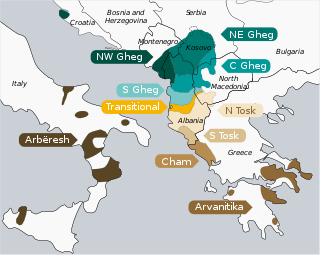Tosk (Albanian definite form: toskërishtja) is the southern group of dialects of the Albanian language, spoken by the ethnographic group known as Tosks. The line of demarcation between Tosk and Gheg (the northern variety) is the Shkumbin River. Tosk is the basis of the standard Albanian language.
| Tosk | |
|---|---|
| toskërishtja | |
| Region | Albania, Kosovo, North Macedonia, Italy, Greece, Turkey |
Native speakers | 1.8 million (2011 census)[1] |
Early form | |
| Dialects |
|
| Albanian alphabet, formerly Elbasan | |
| Language codes | |
| ISO 639-3 | als |
| Glottolog | alba1268tosk1239 |
| Linguasphere | 55-AAA-aca to 55-AAA-ace |
 A map showing Tosk speakers in the two palest shades of brown. | |
Major Tosk-speaking groups include the Myzeqars of Myzeqe, Labs of Labëria, Chams of Çamëria, Arvanites of Greece and the Arbëreshë of Italy, as well as the original inhabitants of Mandritsa in Bulgaria. In North Macedonia, there were approximately 3000 speakers in the early 1980s.[2]
Tosk features
- Rhotacism: Proto-Albanian *-n- becomes -r- (e.g. rëra "sand")
- Tosk dialects preserve groups mb, ngj and nd assimilated to m, nj and n in Gheg.[3]
- Proto-Albanian *ō becomes va.
- Nasal vowels: There is a lack of nasal vowels in Tosk (e.g. sy "eye") and Late Proto-Albanian *â plus a nasal becomes ë (e.g. nëntë "nine").
- e-vowel: The e becomes ë in some varieties in some words qën for qen in Vjosë.
- ë-vowel: The ë may have several pronunciations depending on dialect: the ë is more backed in Labërisht dialects like that of Vuno, where mëz "foal" is [mʌz]). Final -ë drops in many Tosk dialects and lengthens the preceding vowel.
- y-vowel: The y vowel often derounds to i in Labërisht, Çam, Arvanitika and Arbëresh (e.g. dy "two" becomes di).
- Dh and Ll: These sounds may interchange in some words in some varieties.
- H: This may drop in any position in some dialects.
- Gl/Kl: Some varieties of Çam, Arberësh, and Arvanitika retain kl and gl in place of q and gj (e.g. gjuhë "tongue" is gluhë in Çam, gluhë in Siculo-Arberësh, and gljuhë in Arvanitika; "klumësh" for "qumësht" "milk" in Arbëresh).
- Rr: Rr becomes r in some varieties.
Northern Tosk
Vowels
| Front | Central | Back | |
|---|---|---|---|
| Close | i y | u | |
| Close-mid | e | ||
| Open-mid | ɜ | ɔ | |
| Open | a |
- Mid sounds e, o can also be heard as [ɛ, o], in free variation.[4]
See also
References
External links

Tosk Albanian edition of Wikipedia, the free encyclopedia
🔥 Top keywords: Main PageSpecial:SearchIndian Premier LeagueWikipedia:Featured picturesPornhubUEFA Champions League2024 Indian Premier LeagueFallout (American TV series)Jontay PorterXXXTentacionAmar Singh ChamkilaFallout (series)Cloud seedingReal Madrid CFCleopatraRama NavamiRichard GaddDeaths in 2024Civil War (film)Shōgun (2024 miniseries)2024 Indian general electionJennifer PanO. J. SimpsonElla PurnellBaby ReindeerCaitlin ClarkLaverne CoxXXX (film series)Facebook2023–24 UEFA Champions LeagueYouTubeCandidates Tournament 2024InstagramList of European Cup and UEFA Champions League finalsJude BellinghamMichael Porter Jr.Andriy LuninCarlo AncelottiBade Miyan Chote Miyan (2024 film)